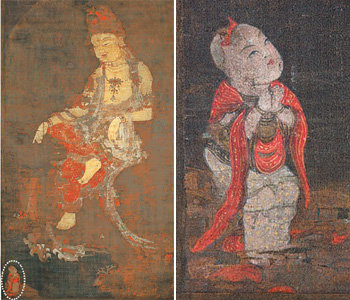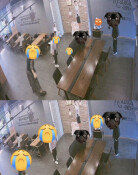14th century Goryeo Buddhist painting discovered in Japan
14th century Goryeo Buddhist painting discovered in Japan
Posted August. 12, 2015 07:41,

Suwolgwaneumdo, which is believed to have been painted in the first half of the 14th century during the Goryeo Dynasty, has been discovered in Tokyo, Japan. The painting is reportedly a rare version that incudes "phoenix pattern veil" described, and only three of the paintings are left worldwide.
When a Buddhist painting possessed by a Japanese individual collector was reviewed in Tokyo, it was found to be Suwolgwaneumdo from the 14th century, said Prof. Chung Woo-taek, an expert of Goryeo Dynasty Buddhist painting and the chief of the Dongguk University Museum. The work has never been publicized thus far, and never been exhibited, or introduced even through a thesis.
Suwolgwaneumdo refers to a painting that describes the images of gwaneumbosal sitting on rock, while teaching Buddhist principle to ordinary people including seojae dongja (child) under moonlight. It is a rare work, with only 45 pieces of the work reportedly remaining. Notably suwolgwaneumdo, which has been discovered this time, has phoenix pattern on veils that covers gwaneums body. Generally, veil features round arabesque pattern or round chrysanthemum pattern, which are drawing attention. There are only three pieces of Suwolgwaneumdo with phoenix veil, including one at Kakami shrine and Jorakuji temple, Japan and the Cologne Asian gallery, Germany.
Prof. Chung said, Although sections of painting before gwaneum and silk in the veil section disappeared, the face and body of gwaneum remains almost complete, adding, Notably, it is a rare case in which Sudhana remains intact in almost perfect condition.
Suwolgwaneumdo is drawn on silk measuring 50 centimeters across and 104.2 centimeters long. It constitutes wonderful presentation of detailed descriptions revealed in gwaneums facial outline, and Sudhanas pure facial expressions. By painting gwaneums face with adhesive paste of golden powder and encolar, the painting is aimed at boosting glaring looks, while showcasing sense of 3-dimensional effect by using barim (painting colored thick with red color on one side and then with increasingly lighter color). Unlike ordinary Buddhist painting from Goryeo, it is a masterpiece that reinstates 3-dimenstional effect of gwaneumbosals face by highlighting barim, and thus instate three dimensional effect of gwaneumbosals face," Prof. Chung said.
sukim@donga.com







